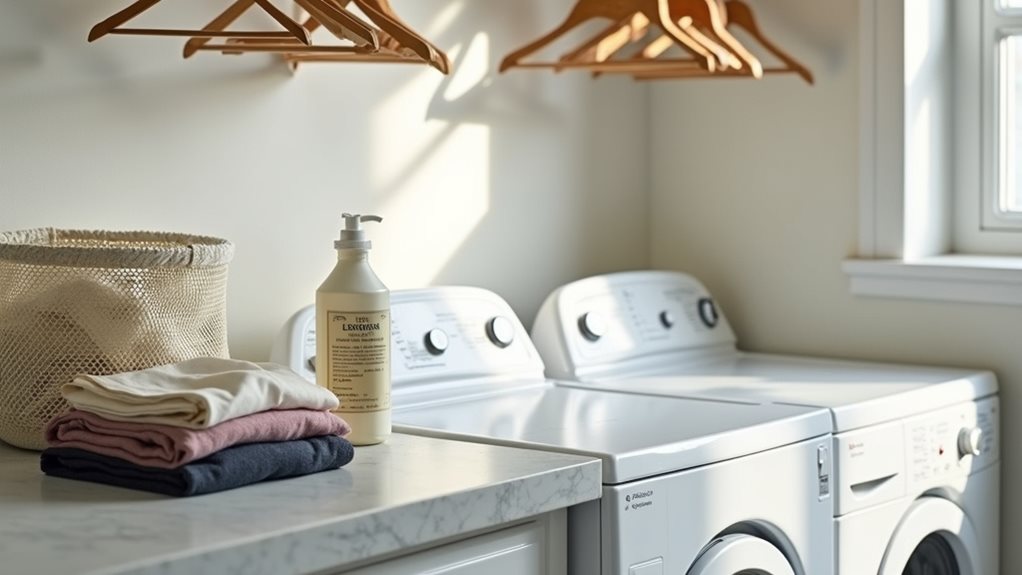You can definitely handle your own dry cleaning at home for many garments, though I’ll admit I was skeptical until I successfully cleaned my favorite polyester blazer using just cool water and delicate detergent. Sturdy fabrics like cotton, polyester, and nylon blends respond well to gentle hand-washing techniques, while items like silk, wool, custom suits, and anything with “dry clean only” labels should stay with the professionals. The secret lies in understanding which fabrics can handle DIY methods and mastering the right techniques to keep your clothes looking fresh.
Understanding Why Certain Garments Require Dry Cleaning
When I first started doing my own laundry in college, I’ll admit I was that person who confidently tossed everything into the washing machine together, thinking soap and water could conquer any fabric challenge life threw at me 😅.
I confidently threw everything together in one load, convinced that soap and water could handle any fabric challenge 😅
That confidence lasted exactly one load, when my favorite silk blouse emerged looking like a sad, shrunken dishrag with colors bleeding everywhere.
Here’s what I learned the hard way: garments labeled “dry clean only” aren’t just being fancy—they’re protecting delicate fabrics like wool, silk, and cashmere from water and agitation damage.
These materials need gentle solvents that prevent shrinkage and color bleeding while effectively tackling oil-based stains.
Professional dry cleaners also have the expertise to handle structured garments like suits and formal wear that can lose their shape and tailored appearance when exposed to the heat and agitation of traditional washing machines.
Understanding your fabric composition helps you decide when professional dry cleaning is worth the investment versus risking disaster.
Essential Materials and Tools for Home Dry Cleaning

You’ll need more than just good intentions to tackle home dry cleaning successfully, and trust me, I learned this the hard way when I tried cleaning my favorite silk blouse with regular laundry detergent 😅.
The right basic cleaning supplies, like gentle detergents and microfiber cloths, will save you from my rookie mistakes, while specialized equipment such as steamers and at-home dry cleaning kits can transform your laundry routine into something almost professional.
Most importantly, you can’t overlook safety and proper ventilation, because nobody wants their home smelling like a chemical factory, and your family’s health should always come first when working with cleaning solvents.
These kits work by using cleaning cloths that are activated by dryer heat to release vapors that penetrate fabric fibers and remove dirt, oils, and odors from your garments.
Basic Cleaning Supplies
Starting your home dry cleaning expedition doesn’t require a treasure chest of expensive equipment, though I’ll admit I once thought I needed to transform my laundry room into some sort of professional operation 😅.
You’ll be amazed at how effective these basic supplies can be when you’re tackling delicate garments at home:
- Mild detergent specifically designed for delicate fabrics, paired with a clean microfiber cloth for precise spot treatment
- Garment bag to protect your clothes during the cleaning process, preventing snags and damage
- Distilled white vinegar and baking soda for freshening garments and absorbing stubborn odors naturally
- Steamer or iron with steam capability, plus a lint brush for removing dust between cleanings
Home dry cleaning kits typically include solvent-treated cloths that work with your dryer’s heat to refresh garments and remove light stains.
Remember to work in a well-ventilated area, especially when using stronger cleaning agents.
Specialized Equipment Needs
Three vital pieces of specialized equipment will transform your home dry cleaning efforts from amateur hour into something that actually works, and trust me, I learned this the hard way after ruining a silk blouse with my overly confident “I don’t need instructions” approach 🤦♀️.
First, invest in proper dry cleaning kits that include reusable dryer bags and cleaning cloths—these aren’t just fancy marketing gimmicks.
Second, you’ll need mild detergents specifically designed for delicate fabrics, because regular laundry soap is basically fabric kryptonite for your nice clothes.
Finally, a garment steamer becomes your best friend for spot cleaning and rejuvenating without damage.
Don’t forget key materials like baking soda for odor absorption and microfiber cloths for gentle at-home dry cleaning treatments.
Unlike professional dry cleaning which uses chemical solvents instead of water, home methods still rely on gentle moisture-based cleaning techniques that require extra care with sensitive materials.
Safety and Ventilation
While gathering all your fancy equipment feels exciting, proper ventilation becomes your invisible lifeline that prevents home dry cleaning from turning into a health hazard—and I learned this lesson after getting lightheaded from cleaning solvent fumes in my poorly ventilated laundry room 😵.
Creating a safe environment requires more than just cracking a window, though that’s definitely your starting point for proper airflow:
- Open multiple windows and turn on exhaust fans before using any mild detergent or cleaning solutions.
- Keep your steamer and garment bag in well-ventilated areas during use.
- Sprinkle baking soda outdoors when possible, since even natural deodorizers need breathing room.
- Always perform spot cleaning colorfastness tests near fresh air sources.
Consider using eco-friendly alternatives like biodegradable solvents or CO2-based cleaning methods, which pose fewer health risks than traditional chemical solvents while still delivering effective results for your delicate garments.
Step-by-Step Process for Dry Cleaning Clothes at Home
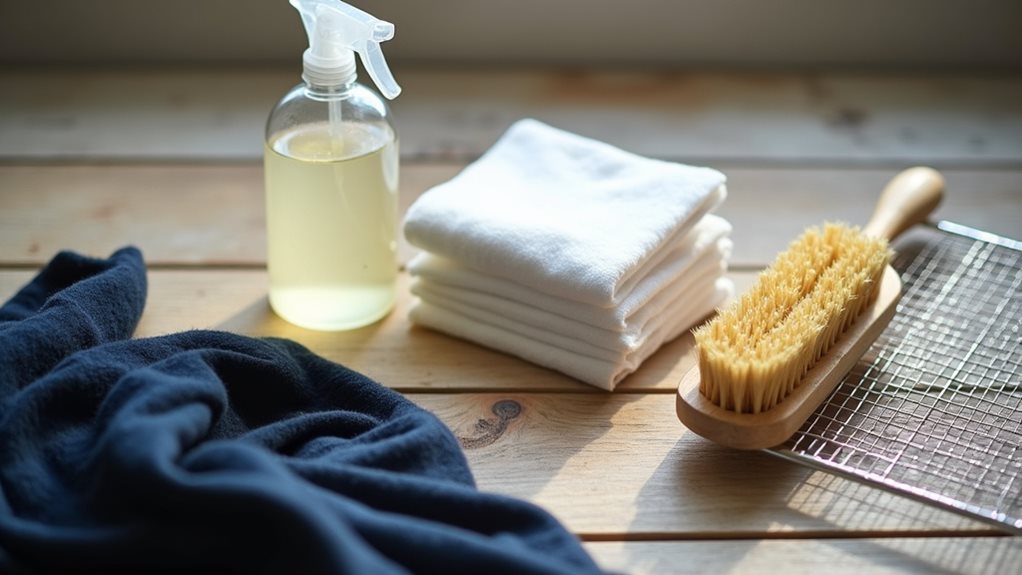
Now that you’ve gathered your materials, it’s time to roll up your sleeves and tackle the actual cleaning process, which honestly feels less intimidating once you break it down into manageable chunks.
The key lies in proper preparation and setup – think of it like prepping for a cooking experiment where you wouldn’t start chopping onions without reading the recipe first, because trust me, I’ve learned that lesson the hard way!
Before diving in, always test your chosen cleaning method on an inconspicuous area first to ensure the fabric won’t be damaged or discolored.
From there, you’ll move through the gentle cleaning process and finish with careful drying techniques that’ll have your clothes looking fresh without the hefty dry cleaner’s bill.
Preparation and Setup
Before diving headfirst into what I lovingly call “home dry cleaning bootcamp,” you’ll want to transform your workspace into something that resembles a professional setup, minus the hefty price tag and judgmental looks when you accidentally shrink your favorite sweater 😅.
Setting yourself up for success means gathering the right tools and creating an environment where you can clean clothes at home without turning your bathroom into a sudsy disaster zone:
- Secure a clean, well-ventilated area with your delicate detergent, garment bag, and steamer ready
- Check care labels religiously—some items genuinely need professional attention
- Test colorfastness on hidden areas before you soak anything important
- Prepare your sink or basin for the gentle rinse process before you hang to dry
This preparation helps absorb odors effectively while protecting your garments throughout the entire dry clean your clothes process. Keep in mind that structured items like suits and coats with interfacing will still require professional dry cleaning due to their construction and materials.
Cleaning and Drying
Once you’ve mastered the art of preparation, the actual cleaning process becomes a surprisingly meditative dance between patience and precision, something I discovered after ruining my first silk blouse by treating it like a cotton t-shirt 🤦♀️.
When you dry clean at home, fill your basin with cool water and a teaspoon of delicate detergent, gently swishing garments for twenty minutes. This cleaning ritual works wonders for delicate items that can’t handle machine washing.
After draining, press—never wring—against the basin’s side to remove excess water, then rinse thoroughly. For drying, lay flat on towels or use home dry cleaning kits like Dryel for stubborn stains. Let everything air dry naturally for best results.
For items with wrinkles or odors after drying, steam treatment can effectively eliminate both issues while maintaining the fabric’s integrity.
Using At-Home Dry Cleaning Kits Effectively
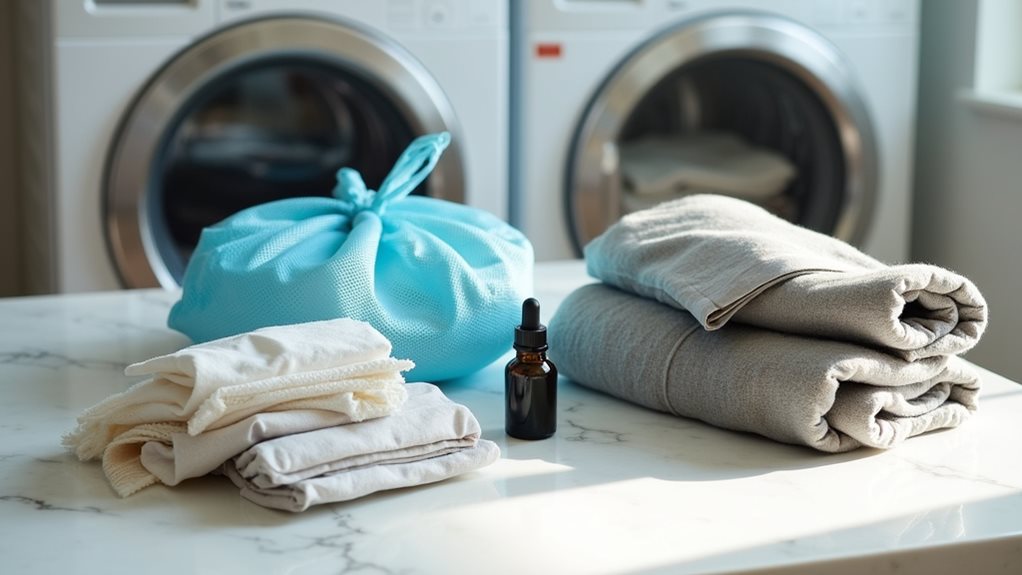
While I used to think at-home dry cleaning kits were just fancy marketing gimmicks, I discovered they’re actually quite effective when you understand their limitations and follow the process correctly.
These kits use steam cleaning technology to freshen delicate fabrics like wool, silk, and rayon, covering about 30 garments per kit.
Here’s my foolproof process for success:
- Always check care labels first and do a colorfastness test on hidden seams
- Pre-treat stains using the included stain-removing pen before anything else
- Place garments in the reusable garment bag with the cleaning cloth
- Run on medium heat for 15-30 minutes in your dryer
Remember that these kits work best for maintaining garments between professional cleanings rather than replacing professional services entirely for heavily soiled items.
Treating Stains on Dry-Clean-Only Garments
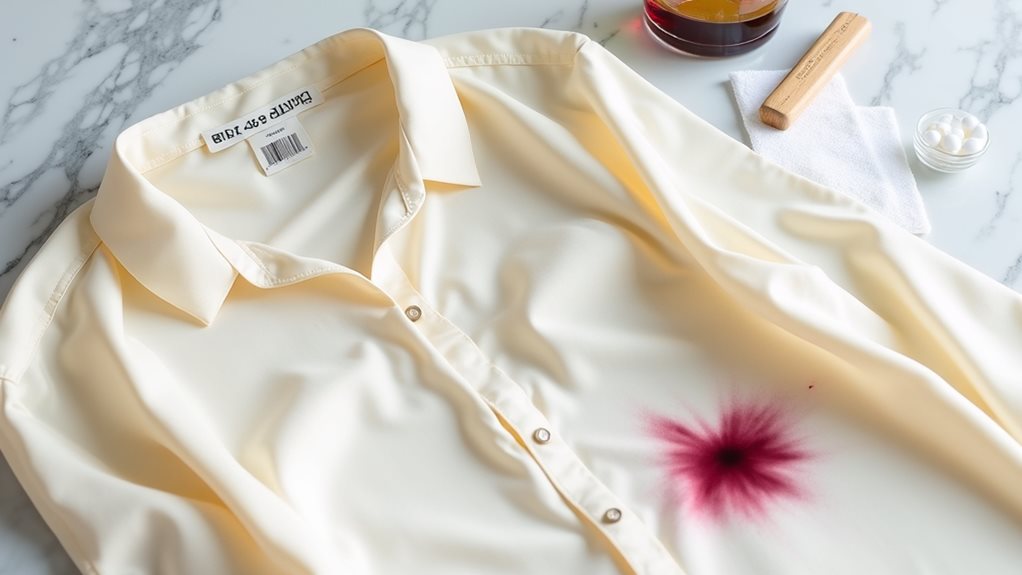
Although I learned this lesson the hard way after ruining a beautiful silk blouse with aggressive scrubbing, treating stains on dry-clean-only garments requires a completely different mindset than your typical laundry approach.
You’ll want to create a gentle mixture of equal parts white vinegar and water, then carefully blot the stained area without any scrubbing motion that could damage those delicate fibers.
Before applying any stain remover, always test an inconspicuous spot first – trust me on this one!
For stubborn oil stains, that same vinegar solution works wonders at breaking down grease.
After treatment, let your garment air dry completely before deciding if professional cleaning is still necessary.
Keep in mind that chemical solvents used in professional dry cleaning are specifically designed to tackle oil-based stains and protein-based stains that home remedies may not be able to handle effectively.
Patience truly pays off here!
Which Fabrics and Items Are Safe for Home Dry Cleaning
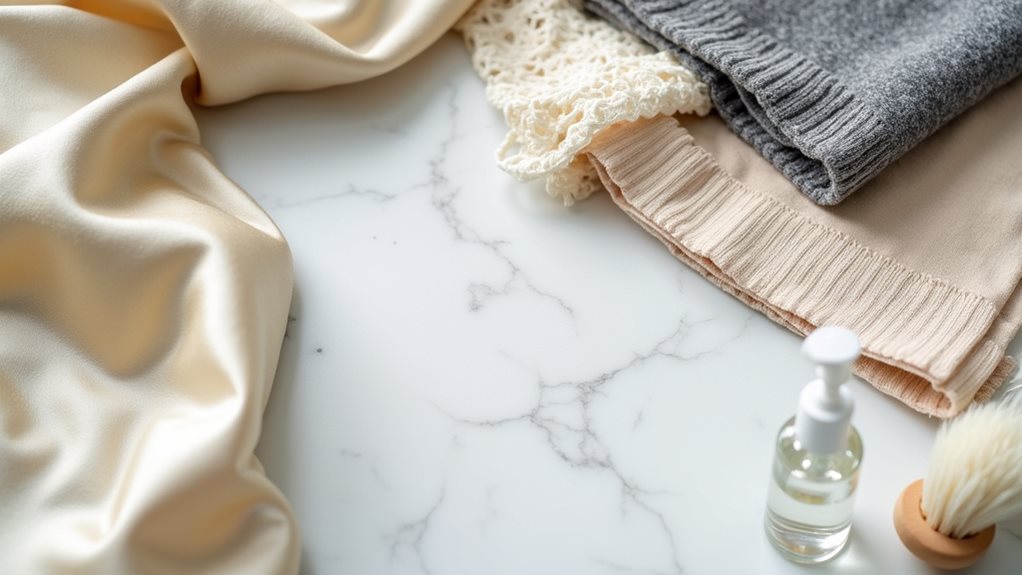
Before you start tossing every piece of clothing into your at-home dry cleaning kit, you’ll need to understand which fabrics can actually handle this gentler-but-still-risky approach without falling apart in your hands.
Think of it like learning to drive—you don’t start with a Ferrari on the highway.
Your best candidates for dry cleaning at home include:
- Sturdy cotton pieces like jeans, casual blouses, and basic trousers
- Polyester garments that aren’t heavily structured or beaded
- Simple outerwear without complex tailoring or padding
- Nylon and spandex blends found in activewear and stretchy fabrics
However, delicate treasures like silk scarves, cashmere sweaters, or your wedding dress deserve a professional dry cleaner’s expertise.
Always check garment care labels first—they’re your fabric’s autobiography, telling you exactly what common household supplies might destroy versus preserve your investment.
Garments That Should Only Be Professionally Dry Cleaned
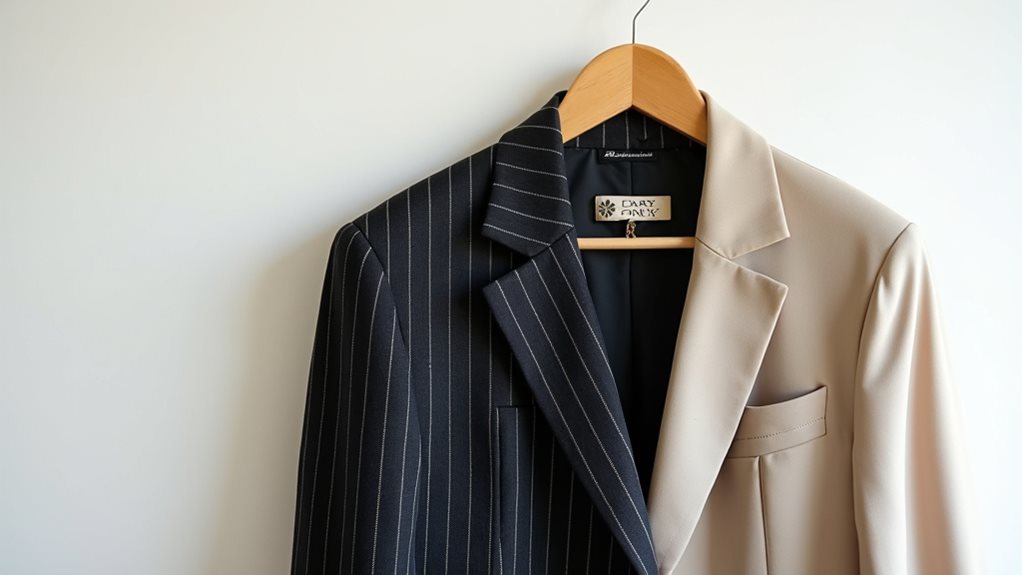
Three expensive mistakes taught me which garments deserve the royal treatment of professional dry cleaning, and trust me, you don’t want to learn these lessons the hard way like I did.
My grandmother’s silk blouse with unique fibers became a wrinkled disaster after I attempted dry cleaning at home, while my husband’s custom suit lost its structure completely 😅.
Delicate fabrics like wool, cashmere, and silk simply can’t handle DIY methods, and structured items need specialized care to maintain their shape.
Leather and suede require expert techniques I definitely don’t possess, and valuable clothing deserves preservation through professional expertise.
When you see “dry clean only” labels, they’re not suggestions—they’re warnings that’ll save your wallet and your wardrobe.
Alternative Methods to Refresh and Steam Clean Clothes
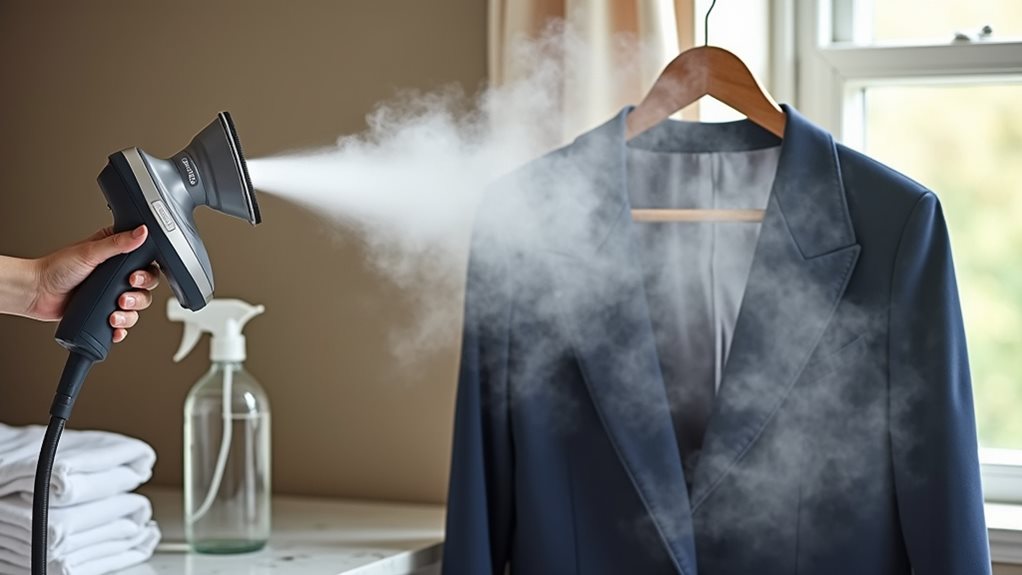
While some garments absolutely need professional care, I’ve discovered several gentle methods that can refresh and revive many clothes between those expensive dry cleaning visits, saving both money and frequent trips to the cleaner.
Steam cleaning has become my go-to solution for breathing new life into wrinkled, slightly odorous clothes at home, especially those delicate pieces that water might damage.
Steam cleaning transforms delicate garments at home, reviving wrinkled pieces and eliminating odors without risking water damage.
Here are my favorite techniques that actually work:
- Hang your garment and use a steamer, or toss a damp washcloth in the dryer for 20 minutes to create gentle steam
- Add a few drops of vital oil to the washcloth for that fresh, clean scent without harsh chemicals
- Air clothes outside for several hours to naturally remove odors and let fabrics breathe
- Mix equal parts white vinegar and water to gently blot light stains before air-drying

